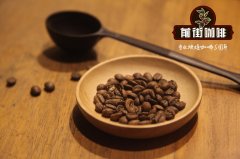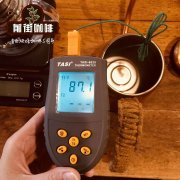Introduction of Ethiopian Hunkute Hungut coffee beans _ how to make Ethiopian coffee

Professional coffee knowledge exchange more coffee bean information please follow the coffee workshop (Wechat official account cafe_style)
This bean comes from the Sidamo region of the Ethiopian coffee producing region in Africa (Sidamo is a fairly large and major coffee producing area in Ethiopia). The raw bean is treated by the Hanggut processing plant, so it is named after the bean. then in order to ensure that the beans have a stable cleanliness, so it is water washing treatment! The variety of Hanggut is native to Ethiopia, and by the way, there are countless native species of coffee trees in the local forests of Ethiopia, which is a very rich treasure house.
At the moment of buying the beans, I was warned by David, the baker who sold the beans, "our beans are not good to bake." I just wanted to talk about it, but I still want to bake the beans. As a result, after drying, Alice is really a little scared, there is a lot of silver skin!
Friends who have the experience of buying coffee and cooked beans should know or hear "Silver skin" more or less, right? Silver skin is some yellowish flakes that may be accompanied by brown coffee beans, which may be attached to the coffee beans or the smiling part in the middle of the beans. The direct taste will taste like tea and should normally be blown away by hot air during baking.
Alice did not give up and tried several times in a row, and found that the results were all the same! After careful consideration, Alice thinks that because of the relationship between the characteristics of Hanggut beans and the baking method, there will be more silver skin on the appearance, but the actual cup test and cooking results will not affect the flavor, on the contrary, it may add a different flavor! So tell your friends who have bought it, don't worry!
Cup test and actual cooking results
Cup test results 2015-2-1
When grinding the beans, I saw the silver skin flying, but there was an invincible fragrance of flowers and tea.
In the part of wet aroma, only the first baked part smelled obvious bergamot, that is, the aroma of Earl Grey Tea.
The second baking is less obvious, but you can still smell it if you work hard.
Sweetness is really full sweetness, there is itching acid after cooling, the smell left in the mouth is very wonderful, it seems that the jasmine is blooming in front of me!
Cup test results 2015-2-2
This time, the cup test is the third pot, and the third pot Alice feels that the similarity between the third pot and the second pot is very high. From the point of view of my own love, I still like the finished product of my first pot best, but when I test the cup with my friends, I still get a good evaluation.
Actually hand-brewed 2015-2-2
Before cooking, Alice took the trouble to mention my cooking equipment and conditions again.
Equipment: VIRUS hand punch pot, Hario V60 ceramic filter cup (model 01), Hario glass pot and 600N Pegasus bean mill
Coffee beans and cooking condition: scale 4.5, coffee beans 15g, water up to 200g, water temperature about 93 degrees.
Visually, you can see a very clean and dazzling orange, as dazzling as the sunset; smell, has already been intoxicated in the fragrance of flowers and tea; taste, of course not surprising, Earl Grey Tea and jasmine, with a little apricot sweet and sour, no matter which time baked, although they all bring a lot of silver skin, but I think the existence of silver skin brought by the smell of tea so that Hunkute has unexpected delicious, really delicious!
In fact, it was boiled in 2015-2-13.
Alice uses its own existing equipment.
Equipment: Hario TCA-5 plug air, using alcohol lamp heating, bean grinder for hand GCM-1
Coffee beans and brewing conditions: three people (360ml) of water and 24g coffee beans, the total cooking time is one minute.
Visually, it is still very orange-red; on the sense of smell, the dry and wet aroma is the same as the hand-made aroma, and the smell is quite wonderful, but this time the wet aroma is more like grapefruit. Earl Grey Tea and jasmine still account for most of the taste, but I don't know whether the concentration of cooking is not as strong as that of hand flushing, the sweet feeling becomes very weak, and the sour part disappears. To answer this question, Alice decided to find another day to try a different gouache ratio!
In fact, it was boiled in 2015-2-18.
The same utensils, capacity, and cooking time as 2x13, but the proportion is changed to 1:14 to try.
The high concentration makes the sweetness in my impression more obvious, the quality and characteristics of coffee beans are still quite outstanding, but the body is really very weak.
Actually hand-brewed 2015-2-24
This time the hand flushing equipment and conditions are different from the past, Alice's own hand flushing apparatus Akira CDP 450 (450ml), made of stainless steel, bean grinder GCM-1,Hario V60 ceramic filter cup (model 01), general heat preservation stainless steel cup as the next pot, and Hario VSS-1 hand frame for brewing; this time the ratio is 1:12 (20g powder, about 220ml water), and the temperature is about 95 degrees.
I have to say, this is the most perfect presentation of this bean baked by Alice itself. There is no shortage of bergamot and jasmine that Hunkute should have. The mellow degree is stronger than the previous two times, and the acidity decreases with the temperature. Sweetness completely conquers my taste buds. Tea feeling is the final change of Hunkute, which is quite pleasant to drink. From hot to cold, you can enjoy the variety of flavor.
The latest cooking results
In the past few days, I will share with you the latest experience of baking beans and cooking. Please look forward to it.
Conclusion
Hunkute is excellent in vision and taste, with bergamot and jasmine flavor, and tea after cooling. It is a bean that most people will like and accept.
Alice thinks that if you flush it by hand, you can try to pull it to a higher temperature (87-89 degrees). Alice thinks it can cook her flavor, or cook it with a high temperature race wind, which is also great.
END
Important Notice :
前街咖啡 FrontStreet Coffee has moved to new addredd:
FrontStreet Coffee Address: 315,Donghua East Road,GuangZhou
Tel:020 38364473
- Prev

Story of poli processing factory in poli village, Ethiopian boutique coffee, sweet and delicate sun Yega Xuefei
Professional coffee knowledge exchange more coffee bean information please follow the coffee workshop (Wechat official account cafe_style) fermented fruit, sweet and delicate sun Yega Chuefei sweet charming, with cranberry, sweet orange taste, supple and delicate taste, sweet finish with honey sweet! P2 ▲ production Information: country: Ethiopia / Ethiopia production area: Yega Ficochel Town / Yirg
- Next

Coffee cultivation in Ethiopia's Hunkute Cooperative _ Ethiopian Organic Coffee producer
Professional coffee knowledge exchange more coffee bean information please follow the coffee workshop (Wechat official account cafe_style) [Hunkute Cooperative] Ethiopia is the birthplace of coffee, there are more than 1.1 million small coffee farmers, the local variety is known as Ethiopia Heirloom. Hunkute is located in the mountains of Sidama in southern Ethiopia. Farmers are at an altitude of 1800.
Related
- Detailed explanation of Jadeite planting Land in Panamanian Jadeite Manor introduction to the grading system of Jadeite competitive bidding, Red bid, Green bid and Rose Summer
- Story of Coffee planting in Brenka region of Costa Rica Stonehenge Manor anaerobic heavy honey treatment of flavor mouth
- What's on the barrel of Blue Mountain Coffee beans?
- Can American coffee also pull flowers? How to use hot American style to pull out a good-looking pattern?
- Can you make a cold extract with coffee beans? What is the right proportion for cold-extracted coffee formula?
- Indonesian PWN Gold Mandrine Coffee Origin Features Flavor How to Chong? Mandolin coffee is American.
- A brief introduction to the flavor characteristics of Brazilian yellow bourbon coffee beans
- What is the effect of different water quality on the flavor of cold-extracted coffee? What kind of water is best for brewing coffee?
- Why do you think of Rose Summer whenever you mention Panamanian coffee?
- Introduction to the characteristics of authentic blue mountain coffee bean producing areas? What is the CIB Coffee Authority in Jamaica?

